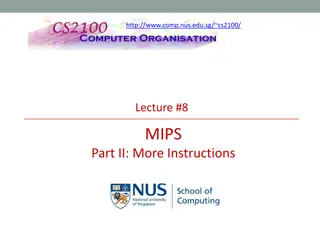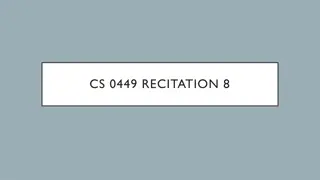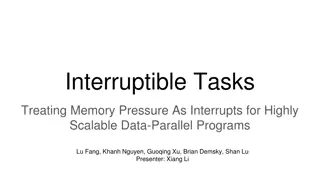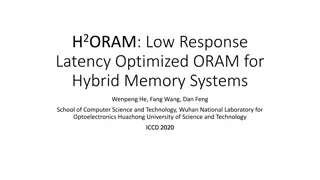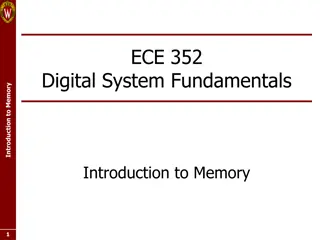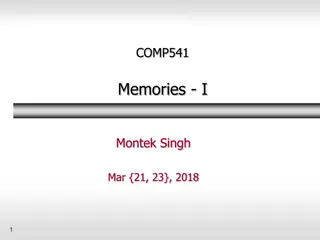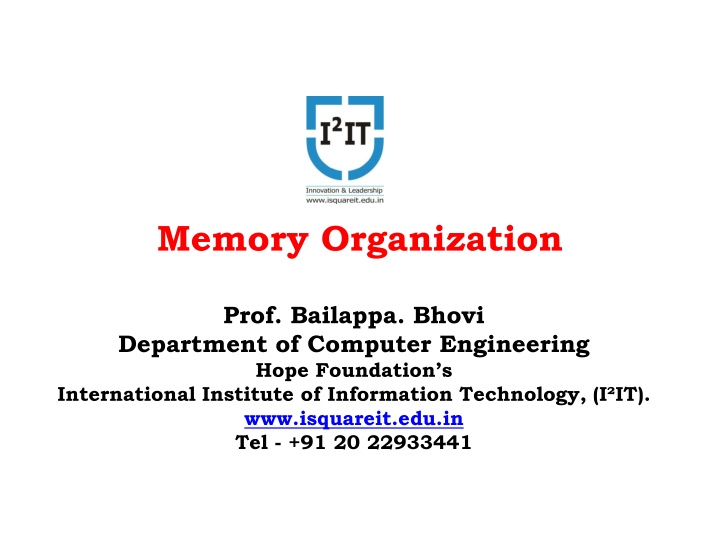
Memory Organization in Computer Engineering
Explore the fundamentals of memory organization in computer engineering, covering topics such as internal memory organization, basic concepts of data transfer, semiconductor memory types, and static vs dynamic RAM. Gain insights into key concepts essential for understanding computer memory systems.
Download Presentation

Please find below an Image/Link to download the presentation.
The content on the website is provided AS IS for your information and personal use only. It may not be sold, licensed, or shared on other websites without obtaining consent from the author. If you encounter any issues during the download, it is possible that the publisher has removed the file from their server.
You are allowed to download the files provided on this website for personal or commercial use, subject to the condition that they are used lawfully. All files are the property of their respective owners.
The content on the website is provided AS IS for your information and personal use only. It may not be sold, licensed, or shared on other websites without obtaining consent from the author.
E N D
Presentation Transcript
Memory Organization Prof. Bailappa. Bhovi Department of Computer Engineering Hope Foundation s International Institute of Information Technology, (I IT). www.isquareit.edu.in Tel - +91 20 22933441
UNIT-2: Internal memory organization Hope Foundation s International Institute of Information Technology, I IT, P-14 Rajiv Gandhi Infotech Park, Hinjawadi, MIDC Phase I, Pune - 411 057 www.isquareit.edu.in | info@isquareit.edu.in | Tel +9120 22933441 / 2 /3
Memory- BasicConcepts Data transfer between the processor and the memory takes place through the two registers MAR and MBR orMDR MAR: The address from which data has to be read/write from memory MBR: The data contents send by memory after supplying address by MAR Memory Speed measurement Memory AccessTime Memory Cycle Time Memory cycle time(Access time + Recovery time) Memory Cycle time for Semiconductor memories ranges 10 to 100 ns Hope Foundation s International Institute of Information Technology, I IT, P-14 Rajiv Gandhi Infotech Park, Hinjawadi, MIDC Phase I, Pune - 411 057 www.isquareit.edu.in | info@isquareit.edu.in | Tel +9120 22933441 / 2 /3
Semiconductor Memory Types Write Mechanism Memory Type Category Erasure Volatility Random-access memory (RAM) Read-write memory Electrically, byte-level Electrically Volatile Read-only memory (ROM) Masks Read-only memory Not possible Programmable ROM (PROM) ErasablePROM (EPROM) UV light,chip- level Nonvolatile Electrically ErasablePROM (EEPROM) Electrically Electrically, byte-level Read-mostly memory Electrically, block-level Flash memory Hope Foundation s International Institute of Information Technology, I IT, P-14 Rajiv Gandhi Infotech Park, Hinjawadi, MIDC Phase I, Pune - 411 057 www.isquareit.edu.in | info@isquareit.edu.in | Tel +9120 22933441 / 2 /3
Static RAM Memories that consists of circuits capable of retaining their state as long as power isapplied Bits stored as on/off switches Complex construction (density less) so larger per bit and moreexpensive Faster operations, used for cache memory Dynamic RAM Bits stored as charge in capacitors chargesleak so need refreshing even when powered Simplerconstruction Smaller per bit so lessexpensive Address line active when bit read or written Slower operations, used for main memory Hope Foundation s International Institute of Information Technology, I IT, P-14 Rajiv Gandhi Infotech Park, Hinjawadi, MIDC Phase I, Pune - 411 057 www.isquareit.edu.in | info@isquareit.edu.in | Tel +9120 22933441 / 2 /3
Memory Chip Organization One dimensional Selectionmethod 16 rows X 8 columns = 128 bits. 8 bit/chiporganization Each row of memory cell(array of memory cells) forms one word of memory To address this mem,a decoder is reqd.Each location can be identified using A0-A3 bits. For any location, its corresponding data can be identified at b0-b7 data lines Pins reqd for memory: 4(address lines) + 8 (data lines)+1(CS)+1(R/W)+2(Vcc ,Gnd)=16 Hope Foundation s International Institute of Information Technology, I IT, P-14 Rajiv Gandhi Infotech Park, Hinjawadi, MIDC Phase I, Pune - 411 057 www.isquareit.edu.in | info@isquareit.edu.in | Tel +9120 22933441 / 2 /3
Two dimensional Selection method Memory organised as matrix of cells, each of which stores a bit A particular cell is selected using row and column decoder Row decoder selects a particular row Column decoder selects a particular Column Cheaper to implement Hope Foundation s International Institute of Information Technology, I IT, P-14 Rajiv Gandhi Infotech Park, Hinjawadi, MIDC Phase I, Pune - 411 057 www.isquareit.edu.in | info@isquareit.edu.in | Tel +9120 22933441 / 2 /3
Organization of a 1K 1 MemoryChip (Two dimensional Selection method ) Pins reqd for memory: 10(address lines) + 1 (data line)+1(CS)+1(R/W)+2(Vcc,Gnd)=15 This design is called 1 bit/chip organization (more preferred) Hope Foundation s International Institute of Information Technology, I IT, P-14 Rajiv Gandhi Infotech Park, Hinjawadi, MIDC Phase I, Pune - 411 057 www.isquareit.edu.in | info@isquareit.edu.in | Tel +9120 22933441 / 2 /3
Memory Organization Issues A 16Mbit chip can be organized as 1M of 16 bit words (One dimension Selection method ) i.e. 1M x 16 = 220 x 16 (20 address lines+16 datalines) =36 pins require to address and data + 4 pins (R/W, CS, PS, G)=40 It can be organized as 4K x 512 x 8 (Two and half dimension Selection method ) i.e. 4k rows X 512 columns X 8(each column contains 8 bits) =(12+9) address lines+ 8 data lines =29 pins are required to address and data + 4 pins(R/W, CS, PS, G)=33 It can be organized as 2048 x 2048 x 4 bit array(Two and half dimension Selection method ) e. 2k rows X 2k columns X 4(each column contains 4 bits) =(11+11) address lines+ 4 data lines =26 pins are required to address and data + 4 pins(R/W, CS, PS, G)= 30 Row address and column address can be multiplexed Same 11 lines can be utilised for representing row as well as columns 11 pins to address (211=2048) + 4 pins for data output + 4 pins = 19 pins Adding one more pin doubles range of values .(capacity increase 4 times) Hope Foundation s International Institute of Information Technology, I IT, P-14 Rajiv Gandhi Infotech Park, Hinjawadi, MIDC Phase I, Pune - 411 057 www.isquareit.edu.in | info@isquareit.edu.in | Tel +9120 22933441 / 2 /3
16 Mbit DRAM Organization (Two and halfdimension Selection method) 2048 x 2048 x 4 =16Mb Row decoder-To select a row from 2k rows RAS-Row address selector ,CAS Column address selector On 11 bit address lines,1st row address will appear so that row is identified Next on same 11 bit address lines, column address will appear so that column is identified Thus location once identified, can transfer its 4 bits to D1-D4 th Data o/p buffer for Read opn And for a write opn D1-D4 has data which is transferred th i/p buffer to identified location Adv: Pins reduced to half ,Disadv : More time Pune - 411 057 www.isquareit.edu.in | info@isquareit.edu.in | Tel +9120 22933441 / 2 /3 Hope Foundation s International Institute of Information Technology, I IT, P-14 Rajiv Gandhi Infotech Park, Hinjawadi, MIDC Phase I,
Synchronous DRAM (SDRAM) Synchronized with processor clock After Read command, data appears after a latency of 2 clockpulses This 2 clk cycle wait can be utilized by the processor for activities that does not need the system bus, e.g. ALUoperations Hope Foundation s International Institute of Information Technology, I IT, P-14 Rajiv Gandhi Infotech Park, Hinjawadi, MIDC Phase I, Pune - 411 057 www.isquareit.edu.in | info@isquareit.edu.in | Tel +9120 22933441 / 2 /3
DDR SDRAM ReadTiming Dual Data rate(DDR) :Each cycle provides 2 bytes of data Data transfer rate double as compared to SDRAM Hope Foundation s International Institute of Information Technology, I IT, P-14 Rajiv Gandhi Infotech Park, Hinjawadi, MIDC Phase I, Pune - 411 057 www.isquareit.edu.in | info@isquareit.edu.in | Tel +9120 22933441 / 2 /3
External memory Semiconductor memory can not be used to store large amount of information or data Due to high per bit cost of it! Large storage requirements is full filled by Magnetic disks, Optical disks and Magnetic tapes Called as secondary storage Hope Foundation s International Institute of Information Technology, I IT, P-14 Rajiv Gandhi Infotech Park, Hinjawadi, MIDC Phase I, Pune - 411 057 www.isquareit.edu.in | info@isquareit.edu.in | Tel +9120 22933441 / 2 /3
Disk Connection to the System Bus Disk controller acts as a interface between system bus and the disk drive (handles the speed or data transfer rate mismatch) Single disk controller can control more than 1 disk Hope Foundation s International Institute of Information Technology, I IT, P-14 Rajiv Gandhi Infotech Park, Hinjawadi, MIDC Phase I, Pune - 411 057 www.isquareit.edu.in | info@isquareit.edu.in | Tel +9120 22933441 / 2 /3
Data Organization on Disk Hard disk divided into tracks and sectors Concentric rings called tracks Gaps between tracks Same number of bits per track Constant angular velocity Tracks divided into sectors Minimum block size is one sector-512 bytes can be read/written at a time Individual tracks and sectors addressable For reading particular info, the head has to move desired track and then the disk has to rotate so that desired sector comes under the head Direct + sequential access method Hope Foundation s International Institute of Information Technology, I IT, P-14 Rajiv Gandhi Infotech Park, Hinjawadi, MIDC Phase I, Pune - 411 057 www.isquareit.edu.in | info@isquareit.edu.in | Tel +9120 22933441 / 2 /3
Multi Zone Recording Disks Single zone recording disc Linear distance of innermost track is less than that of outermost track Density of bits more in inner sectors/tracks. For outer tracks we are wasting recording space in CAV(Constant angular velocity ) system Solution : Multi Zone RecordingDisks Hope Foundation s International Institute of Information Technology, I IT, P-14 Rajiv Gandhi Infotech Park, Hinjawadi, MIDC Phase I, Pune - 411 057 www.isquareit.edu.in | info@isquareit.edu.in | Tel +9120 22933441 / 2 /3 Multi Zone Recording Disks Better space utilization Linear length of sector is same More sectors as we go outwards For each zone the recording/reading speed will be different i.e. Zone wise velocity will be different
Multiple Platters Tracks and Cylinders For each surface separate head is there Set of tracks having same relative distance w.r.t center form a cylinder C y l i n d e r Hope Foundation s International Institute of Information Technology, I IT, P-14 Rajiv Gandhi Infotech Park, Hinjawadi, MIDC Phase I, Pune - 411 057 www.isquareit.edu.in | info@isquareit.edu.in | Tel +9120 22933441 / 2 /3
Capacity Capacity generally express in units of gigabytes (GB), where 1 GB =10^9 Byte Capacity is determined by these technology factors: Recording density (bits/inch): number of bits that can be squeezed into a 1 inch segment of a track. Track density (tracks/inch): number of tracks that can be squeezed into a 1 inch radial segment. Areal density (bits/sq.inch): product of recording and track density. Modern disks partition tracks into disjoint subsets called recording zones(multiple zone disc) Hope Foundation s International Institute of Information Technology, I IT, P-14 Rajiv Gandhi Infotech Park, Hinjawadi, MIDC Phase I, Pune - 411 057 www.isquareit.edu.in | info@isquareit.edu.in | Tel +9120 22933441 / 2 /3
Computing Disk Capacity Capacity =(# bytes/sector) x (avg. # sectors/track) x (# tracks/surface) x (# surfaces/platter) x (# platters/disk) Example: 512 bytes/sector, 300 sectors/track (average) 20,000 tracks/surface, 2 surfaces/platter 5 platters/disk Capacity = 512 x 300 x 20000 x 2 x 5 = 30.72GB Hope Foundation s International Institute of Information Technology, I IT, P-14 Rajiv Gandhi Infotech Park, Hinjawadi, MIDC Phase I, Pune - 411 057 www.isquareit.edu.in | info@isquareit.edu.in | Tel +9120 22933441 / 2 /3
Computing Disk Capacity Capacity =(# bytes/sector) x (avg. # sectors/track) x (# tracks/surface) x (# surfaces/platter) x (# platters/disk) Example: 512 bytes/sector, 200 sectors/track (average) 50,000 tracks/surface, 2 surfaces/platter 3 platters/disk. Find the capacity. Hope Foundation s International Institute of Information Technology, I IT, P-14 Rajiv Gandhi Infotech Park, Hinjawadi, MIDC Phase I, Pune - 411 057 www.isquareit.edu.in | info@isquareit.edu.in | Tel +9120 22933441 / 2 /3
Disk Performance Parameters Access time for disc is greater than that for cache/main memory or semiconductormemory. Seek time (Ts) Time require to positioned the head on the desired track (in ms due to mechanical system) Rotationaldelay Time require to positioned desired sector under r/w head (for each sector rotation is different, thus consider average rotation) Transfer time -- Time required for reading /recording disk The Total average access time is: Ta = Ts+ 1/2r + b/rN Here Ts is Average seek time r is rotation speed in revolution per second b number of bytes to be transferred N number of bytes on atrack Hope Foundation s International Institute of Information Technology, I IT, P-14 Rajiv Gandhi Infotech Park, Hinjawadi, MIDC Phase I, Pune - 411 057 www.isquareit.edu.in | info@isquareit.edu.in | Tel +9120 22933441 / 2 /3
Performance Improvement in Secondary Storage In general multiple components improves the performance Similarly multiple disks should reduce accesstime? Arrays of disks operates independently and in parallel Also used as standby if one or more disk fails Used where response time is critical Justification With multiple disks separate I/O requests can be handled in parallel A single I/O request can be executed in parallel, if the requested data is distributed across multiple disks Researchers @ University of California-Berkeley proposed the RAID (1988) Hope Foundation s International Institute of Information Technology, I IT, P-14 Rajiv Gandhi Infotech Park, Hinjawadi, MIDC Phase I, Pune - 411 057 www.isquareit.edu.in | info@isquareit.edu.in | Tel +9120 22933441 / 2 /3
RAID Redundant Array of Independent Disks Seven levels in common use Not a hierarchy Characteristics 1. Set of physical disks viewed as single logical drive by operating system 2. Data distributed across physical drives 3. Can use redundant capacity to store parity information Hope Foundation s International Institute of Information Technology, I IT, P-14 Rajiv Gandhi Infotech Park, Hinjawadi, MIDC Phase I, Pune - 411 057 www.isquareit.edu.in | info@isquareit.edu.in | Tel +9120 22933441 / 2 /3
Data Mapping in RAID0 Data is distributed across the disk in strips :0,1,2,3 Work distributed among 4 disks No redundancy Data striped across all disks Round Robinstriping Increased Speed Multiple data requests probably not on same disk Disks seek in parallel A set of data is likely to be striped across multiple disks Draw Backs: Not a "True" RAID because it is NOT fault-tolerant The failure of just one drive will result in all data in an array being lost Hope Foundation s International Institute of Information Technology, I IT, P-14 Rajiv Gandhi Infotech Park, Hinjawadi, MIDC Phase I, Pune - 411 057 www.isquareit.edu.in | info@isquareit.edu.in | Tel +9120 22933441 / 2 /3
RAID 1 Mirrored Disks ,Data is striped across disks 2 copies of each stripe on separate disks In case hard disk fails, parallel disk can work Read from either and Write to both If N is no.of data disk ,thenRedundency-2N Recovery is simple Swap faulty disk & re-mirror No downtime Draw back Highest disk overhead of all RAID types (For any write,2 copies are to be made Expensive Any write should be done on two disks Hope Foundation s International Institute of Information Technology, I IT, P-14 Rajiv Gandhi Infotech Park, Hinjawadi, MIDC Phase I, Pune - 411 057 www.isquareit.edu.in | info@isquareit.edu.in | Tel +9120 22933441 / 2 /3
Data Mapping in RAID2 Some parity info of data is stored so that if any disk fails, then data can be recovered. Lots of redundancy Expensive: Good for erroneous disk If N is no.of data disk ,then Redundancy-logN Use parallel access technique Very small size strips Error correcting code is calculated across corresponding bits on each data disks Multiple parity disks store Hamming code error correction in corresponding positions Hope Foundation s International Institute of Information Technology, I IT, P-14 Rajiv Gandhi Infotech Park, Hinjawadi, MIDC Phase I, Pune - 411 057 www.isquareit.edu.in | info@isquareit.edu.in | Tel +9120 22933441 / 2 /3
Data Mapping in RAID 3 X1 X0 X2 X3 X4 Similar to RAID 2 Bit interleaved parity used Only one redundant disk, no matter how large the array Simple parity bit for each set of corresponding bits Data on failed drive can be reconstructed from surviving data and parity information e.g. For ithbit, parity will be stored as: X4(i) = X3 (i) xor X2(i) xor X1 (i) xor X0(i) If X2 disc is failed ,its data can be recovered as follows: Xoring X4 (i) xor X2(i) on both sides of equation ,we get: X2(i) = X3 (i) xor X1 (i) xor X0 (i) xor X4(i) Hope Foundation s International Institute of Information Technology, I IT, P-14 Rajiv Gandhi Infotech Park, Hinjawadi, MIDC Phase I, Pune - 411 057 www.isquareit.edu.in | info@isquareit.edu.in | Tel +9120 22933441 / 2 /3
RAID 4 Make use of independent access with block level striping Good for high I/O request rate due to large strips Bit by bit parity calculated across stripes on eachdisk Parity stored on parity disk If N is no.of data disk ,then N+1 are total diskreqd. If any disk gets modified, then Parity disk will get modified simultaneously ,thus a long queue can be there for writing parity info. corresponding to the blocks Hope Foundation s International Institute of Information Technology, I IT, P-14 Rajiv Gandhi Infotech Park, Hinjawadi, MIDC Phase I, Pune - 411 057 www.isquareit.edu.in | info@isquareit.edu.in | Tel +9120 22933441 / 2 /3
RAID 5 Parity disc distributed along each disk(No.of disk are same) Round robin allocation for parity stripe It avoids RAID 4 bottleneck at paritydisk Commonly used in network servers Drawback Disk failure has a medium impact onthroughput Difficult to rebuild in the event of a disk failure (as compared to RAID level 1) Hope Foundation s International Institute of Information Technology, I IT, P-14 Rajiv Gandhi Infotech Park, Hinjawadi, MIDC Phase I, Pune - 411 057 www.isquareit.edu.in | info@isquareit.edu.in | Tel +9120 22933441 / 2 /3
RAID6 Two parity calculations are distributed along the disk Stored in separate blocks on different disks If 2 disk fail, then also data can be recovered If N is no.of data disk ,then N+2 are total diskreqd. High data availability Three disks need to fail for data loss Significant write penalty Drawback Controller overhead to compute parity is very high Hope Foundation s International Institute of Information Technology, I IT, P-14 Rajiv Gandhi Infotech Park, Hinjawadi, MIDC Phase I, Pune - 411 057 www.isquareit.edu.in | info@isquareit.edu.in | Tel +9120 22933441 / 2 /3
THANK YOU For further information please contact Bailappa Bhovi Department of Computer Engineering Hope Foundation s International Institute of Information Technology, I IT P-14, Rajiv Gandhi Infotech Park, MIDC Phase 1, Hinjawadi, Pune 411 057 Phone - +91 20 22933441 www.isquareit.edu.in | bailappab@isquareit.edu.in | info@isquareit.edu.in

